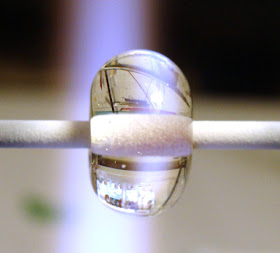
Formally known as Deesigned Beads, I thought it best to rename my blog title to the current one, as I have a tiny little shop in the shades of Table Mountain, Cape Town with the same name. Here I write sometimes about my life in Cape Town, show you images of my work (Glass, Ceramics, Silver) and throw in a glassy tutorial every now and then! Thank you for visiting my blog!
Monday, June 28, 2010
swirly pendants
I had forgotten to add these photos when I wrote the tutorial earlier! Here I just used one layer of swirls ...


A Whirly Gravity Bead Tutorial
 Hey all!
Hey all! It has been quite some time since I have posted anything, let alone a tutorial. but I have been enjoying making these beads so much, I had to share it with you all!
The time it took me to make one of these beads is roughly about 20 - 30 minutes. They are HUGE! But then I use them in my candle sticks, so that is good, hehehehe. I have used plain old Moretti clear glass (my oxycon seems to be doing the trick, as I could not, for the life of me, use this glass on my Hot Head or while I used tanked oxygen), some white and intense black commercial stringer. I used a 2,5 mm stainless steel mandrel, and tools ... What tools??? OK, I did use the base of a brass press to measure the size of the initial cylinder and I used my trusty old scalpel blade to flatten the added colour a bit.
OK, lets start ... Here is some images of beads that I made for this tutorial. Lots of whirls of colour embedded in the clear glass, the colour seem to float and drift in the glass. I have allowed air bubbles to be trapped in the glass, as I felt that it added a something to the plain design. But that is just me ...



I started off by making a biggish doughnut. I used about 4 thick wraps of glass to create it. I want to press the glass to a width of about 25 mm.

Here I have pressed the doughnut and measured it on my trusty brass press. As mentioned earlier, I aim to get my footpath about 25 mm.

Using the commercial stringer, I add a slightly wobbly line of white on the clear tube. I make sure that the start and finish is slightly 'fuller' loaded with colour. You will later see why it might be a good idea to do that! I do not want the whirls of colour to start at the same place, thus the slightly skew application. The amount of glass that I have loaded on the barrel is quite a lot, and if I encase this, I would create to many air bubbles.

So I heat up the stringer a bit, and flatten the white a bit ...

Then it is time to encase it. I just use an 'around the world' technique, but quite frankly - you could use your favourite one. Just ensure that you have covered the colour band completely. Melt in smoothly, and at the same time start heating up the whole bead on the mandrel. You want this baby to be super hot!

As the glass on the mandrel starts to smooth out, I start turning the mandrel slower, watching for the tsunami wave to start moving on the glass. Here I have allowed the wave to go to the bottom of the bead (damn difficult to turn a mandrel and take a picture!). I aim to keep that pointy bit (the wave) more in a horizontal position). Now I slowly turn the mandrel, keeping my eye on the wave, allowing it to shift as I turn the bead. With the white glass that I added, I need to stop sometimes, allow the glass to cool a bit so I can see how many swirls I have created. Other colours does not do disappearing acts like the white!

Ah, the swirls! Can you see how the thick start and end of the white glass has thinned out? But because of the volume of glass that I loaded, it is still visible.

Now it is time to add the second colour for the swirls. Or, if you want, you can skip this application and add some more clear glass to round out the bead ...
Again I add glass in a slightly skew line. BUT - I add less black glass to the bead, compared to the amount that I loaded with the white.

Encase ... (ensure that all the black is covered)

Melt smooth and allow it to start shifting. Ride dem wave! The black glows nice and orange, showing me how far the glass has moved. Your white lines will move a bit with this, too.

Aha. I have shifted the black so that the centre swirl has passed the 2 outside starting/ending points. I take the bead out of the flame, continuously turning the mandrel, allowing the glass to center itself around the mandrel again.

The bead needs some more glass, so I add a few lines of glass around the center and perimeters.

Melt smooth, and Voila!

Enjoy this fun technique!
